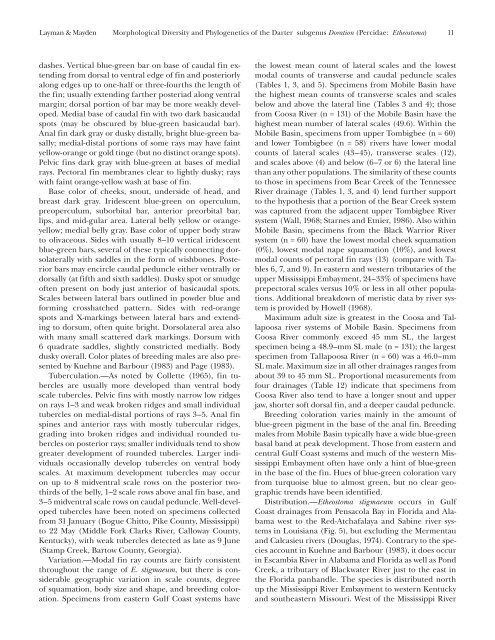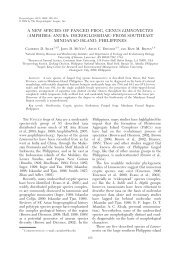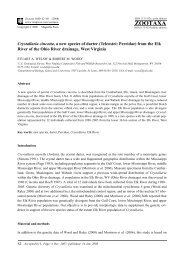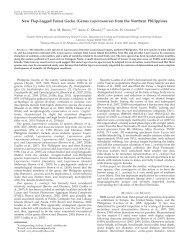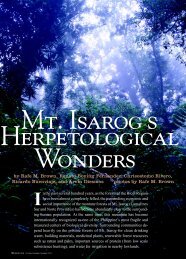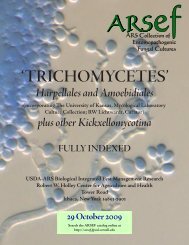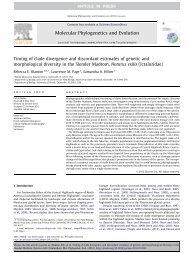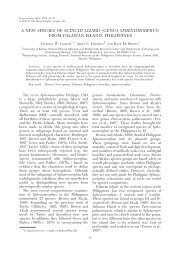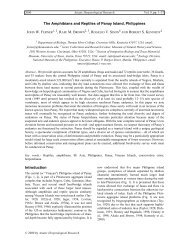(Percidae: Etheostoma), with Descriptions of Five New Species
(Percidae: Etheostoma), with Descriptions of Five New Species
(Percidae: Etheostoma), with Descriptions of Five New Species
- No tags were found...
Create successful ePaper yourself
Turn your PDF publications into a flip-book with our unique Google optimized e-Paper software.
Layman & Mayden Morphological Diversity and Phylogenetics <strong>of</strong> the Darter subgenus Doration (<strong>Percidae</strong>: <strong>Etheostoma</strong>) 11dashes. Vertical blue-green bar on base <strong>of</strong> caudal fin extendingfrom dorsal to ventral edge <strong>of</strong> fin and posteriorlyalong edges up to one-half or three-fourths the length <strong>of</strong>the fin; usually extending farther posteriad along ventralmargin; dorsal portion <strong>of</strong> bar may be more weakly developed.Medial base <strong>of</strong> caudal fin <strong>with</strong> two dark basicaudalspots (may be obscured by blue-green basicaudal bar).Anal fin dark gray or dusky distally, bright blue-green basally;medial-distal portions <strong>of</strong> some rays may have faintyellow-orange or gold tinge (but no distinct orange spots).Pelvic fins dark gray <strong>with</strong> blue-green at bases <strong>of</strong> medialrays. Pectoral fin membranes clear to lightly dusky; rays<strong>with</strong> faint orange-yellow wash at base <strong>of</strong> fin.Base color <strong>of</strong> cheeks, snout, underside <strong>of</strong> head, andbreast dark gray. Iridescent blue-green on operculum,preoperculum, suborbital bar, anterior preorbital bar,lips, and mid-gular area. Lateral belly yellow or orangeyellow;medial belly gray. Base color <strong>of</strong> upper body strawto olivaceous. Sides <strong>with</strong> usually 8–10 vertical iridescentblue-green bars, several <strong>of</strong> these typically connecting dorsolaterally<strong>with</strong> saddles in the form <strong>of</strong> wishbones. Posteriorbars may encircle caudal peduncle either ventrally ordorsally (at fifth and sixth saddles). Dusky spot or smudge<strong>of</strong>ten present on body just anterior <strong>of</strong> basicaudal spots.Scales between lateral bars outlined in powder blue andforming crosshatched pattern. Sides <strong>with</strong> red-orangespots and X-markings between lateral bars and extendingto dorsum, <strong>of</strong>ten quite bright. Dorsolateral area also<strong>with</strong> many small scattered dark markings. Dorsum <strong>with</strong>6 quadrate saddles, slightly constricted medially. Bodydusky overall. Color plates <strong>of</strong> breeding males are also presentedby Kuehne and Barbour (1983) and Page (1983).Tuberculation.—As noted by Collette (1965), fin tuberclesare usually more developed than ventral bodyscale tubercles. Pelvic fins <strong>with</strong> mostly narrow low ridgeson rays 1–3 and weak broken ridges and small individualtubercles on medial-distal portions <strong>of</strong> rays 3–5. Anal finspines and anterior rays <strong>with</strong> mostly tubercular ridges,grading into broken ridges and individual rounded tubercleson posterior rays; smaller individuals tend to showgreater development <strong>of</strong> rounded tubercles. Larger individualsoccasionally develop tubercles on ventral bodyscales. At maximum development tubercles may occuron up to 8 midventral scale rows on the posterior twothirds<strong>of</strong> the belly, 1–2 scale rows above anal fin base, and3–5 midventral scale rows on caudal peduncle. Well-developedtubercles have been noted on specimens collectedfrom 31 January (Bogue Chitto, Pike County, Mississippi)to 22 May (Middle Fork Clarks River, Calloway County,Kentucky), <strong>with</strong> weak tubercles detected as late as 9 June(Stamp Creek, Bartow County, Georgia).Variation.—Modal fin ray counts are fairly consistentthroughout the range <strong>of</strong> E. stigmaeum, but there is considerablegeographic variation in scale counts, degree<strong>of</strong> squamation, body size and shape, and breeding coloration.Specimens from eastern Gulf Coast systems havethe lowest mean count <strong>of</strong> lateral scales and the lowestmodal counts <strong>of</strong> transverse and caudal peduncle scales(Tables 1, 3, and 5). Specimens from Mobile Basin havethe highest mean counts <strong>of</strong> transverse scales and scalesbelow and above the lateral line (Tables 3 and 4); thosefrom Coosa River (n = 131) <strong>of</strong> the Mobile Basin have thehighest mean number <strong>of</strong> lateral scales (49.6). Within theMobile Basin, specimens from upper Tombigbee (n = 60)and lower Tombigbee (n = 58) rivers have lower modalcounts <strong>of</strong> lateral scales (43–45), transverse scales (12),and scales above (4) and below (6–7 or 6) the lateral linethan any other populations. The similarity <strong>of</strong> these countsto those in specimens from Bear Creek <strong>of</strong> the TennesseeRiver drainage (Tables 1, 3, and 4) lend further supportto the hypothesis that a portion <strong>of</strong> the Bear Creek systemwas captured from the adjacent upper Tombigbee Riversystem (Wall, 1968; Starnes and Etnier, 1986). Also <strong>with</strong>inMobile Basin, specimens from the Black Warrior Riversystem (n = 60) have the lowest modal cheek squamation(0%), lowest modal nape squamation (10%), and lowestmodal counts <strong>of</strong> pectoral fin rays (13) (compare <strong>with</strong> Tables6, 7, and 9). In eastern and western tributaries <strong>of</strong> theupper Mississippi Embayment, 24–33% <strong>of</strong> specimens haveprepectoral scales versus 10% or less in all other populations.Additional breakdown <strong>of</strong> meristic data by river systemis provided by Howell (1968).Maximum adult size is greatest in the Coosa and Tallapoosariver systems <strong>of</strong> Mobile Basin. Specimens fromCoosa River commonly exceed 45 mm SL, the largestspecimen being a 48.9–mm SL male (n = 131); the largestspecimen from Tallapoosa River (n = 60) was a 46.0–mmSL male. Maximum size in all other drainages ranges fromabout 39 to 45 mm SL. Proportional measurements fromfour drainages (Table 12) indicate that specimens fromCoosa River also tend to have a longer snout and upperjaw, shorter s<strong>of</strong>t dorsal fin, and a deeper caudal peduncle.Breeding coloration varies mainly in the amount <strong>of</strong>blue-green pigment in the base <strong>of</strong> the anal fin. Breedingmales from Mobile Basin typically have a wide blue-greenbasal band at peak development. Those from eastern andcentral Gulf Coast systems and much <strong>of</strong> the western MississippiEmbayment <strong>of</strong>ten have only a hint <strong>of</strong> blue-greenin the base <strong>of</strong> the fin. Hues <strong>of</strong> blue-green coloration varyfrom turquoise blue to almost green, but no clear geographictrends have been identified.Distribution.—<strong>Etheostoma</strong> stigmaeum occurs in GulfCoast drainages from Pensacola Bay in Florida and Alabamawest to the Red-Atchafalaya and Sabine river systemsin Louisiana (Fig. 5), but excluding the Mermentauand Calcasieu rivers (Douglas, 1974). Contrary to the speciesaccount in Kuehne and Barbour (1983), it does occurin Escambia River in Alabama and Florida as well as PondCreek, a tributary <strong>of</strong> Blackwater River just to the east inthe Florida panhandle. The species is distributed northup the Mississippi River Embayment to western Kentuckyand southeastern Missouri. West <strong>of</strong> the Mississippi River


